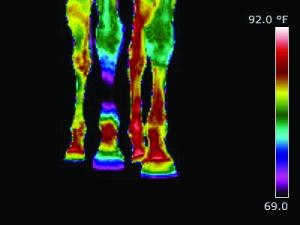By Leigh Ballard
Equine thermography is performed with highly sensitive infrared cameras which measure heat radiating from the surface area of a horse. Thermal imaging is considered to be a physiologic diagnostic modality because it examines physiologic processes like blood flow and circulation patterns. Traditional diagnostics like radiographs (x-ray) and ultrasound are anatomic diagnostic modalities because they look at anatomical structures like bones and tendons. Dr. Joanna Robson, the Veterinary Technical Director of EquineIR, an international network of equine thermographers, explains, “An anatomic diagnostic modality will show a specific lesion or problem in an anatomic structure at a static moment in time. A physiologic modality such as thermal imaging cannot show a specific anatomic lesion, but does show a physiologic change in blood flow that helps to localize a lesion and more easily shows changes over time.”
Thermal imaging should show symmetrical patterns in the horse’s body. If an abnormality or anomaly in the pattern is evident, it would be considered an area of concern for injury. Heat radiates from damaged or stressed anatomical structures. Studies by Dr. Tracy Turner have shown that thermography can detect heat from a developing injury up to three weeks before a horse will show signs of a problem.
Dr. Robson provides some insight into common horse injuries and their causes: “Equine injuries could be subdivided into: accidental, human-induced, and physiologic or naturally occurring. Accidental injuries would include lacerations and scrapes, broken bones and soft-tissue injuries that occur as a result of a horse playing, falling or slipping, encountering sharp objects, trailer traumas, or injured by another horse. Human-induced problems include all those that are caused by our intentional or unintentional ignorance. For example, the soring of gaited horses (intentional application of a caustic substance to exaggerate a desired movement), ill-fitting saddles, poor trimming and shoeing, imbalanced or forceful riding, and failure to recognize signs of early lameness that results in more significant disease and injury. Physiologic or naturally occurring diseases are those such as arthritis or kissing spine, laminitis, age-related changes (hormonal), cancer, or infections (EPM, EHV-1). These categories are often overlapping. Man’s forceful riding on uneven ground will lead to tendon and ligament tears, or early arthritis. Man’s racing of a young horse with an undiagnosed hairline fracture, may result in a fatal “accidental” breakdown.
Some specific major common diseases or pathologies resulting in decreased performance, lengthy rehabilitation, or retirement include suspensory ligament tears, tendon tears, sacroiliac problems, spinal lesions, cervical problems, arthritis, and damage from ill-fitting saddles.”
Robson, an experienced equine thermographer, explains the role of thermography in horse health as follows: “Thermal imaging is useful throughout the equine industry, but the tool finds its niche in a few key areas: injury detection and prevention, pre-purchase evaluations, saddle-fitting, and farriery. The injuries and diseases listed earlier produce inflammation or changes in bloodflow that are directly related to radiant heat emitted from the body surface. Likewise, a lack of circulation may also be an indicator of disease, and muscle atrophy, nerve damage, scar tissue, and circulatory disruption may also be detected with thermal imaging.
Pre-purchase evaluations are often a veterinarian’s nightmare. Making decisions about whether or not a horse is suitable for purchase based on a general physical examination, radiographs of specific joints, and perhaps an endoscopy, misses a large percentage of the patient – all the soft tissues and regions that cannot be palpated or evaluated with a traditional modality! Utilizing a non-invasive WHOLE BODY scan as part of a pre-purchase evaluation to determine whether there are other “hidden” lesions present can make a significant impact on the buying and selling of horses. Thermography has the potential to become a standard practice in equine buying and selling due to its being non-invasive and generally inexpensive. The cost-to-benefit ratio of the scan in a pre-purchase evaluation is one of its greatest attributes.
Saddles and equipment play a significant role in equine performance. Many clients need the objective image evidence of the inflammation that is caused by their ill-fitting tack to be spurned into making positive changes.
Farriers are also taking great notice of thermal imaging capabilities. From evaluating hoof imbalances, to diagnosing laminitis and abscesses, this tool can help to stage disease or locate problems. Navicular syndrome and laminitis both have a huge financial impact on the equine industry, and thermal imaging is playing a role in the research of both diseases.”
Other thermal imaging niches include track and arena footing scans, and the eliminating of soring and other unethical practices (tail blocking, nerving, etc.). The FEI currently sanctions thermal imaging as a tool to determine whether a horse is fit to compete, or if its legs have been tampered with.”
Robson emphasizes the importance of a trained eye for interpreting the thermographic images. She says, “Interpretation of the images is the other half of a successful imaging equation in a modality dependent on symmetry. In keeping with state veterinary practice laws, thermal imaging interpretation must be done by a licensed VETERINARIAN. Even more important, in addition to a solid understanding of patient anatomy, an interpreting veterinarian must have an understanding of thermal imaging technology to correctly relate the images with possible physiologic changes. ”Robson sums it up nicely when she says, “Thermal imaging isn’t new to the horse world, though it’s finding its renaissance in today’s performance-charged equine industry. With trained technicians and veterinary interpretation, thermal imaging is taking its deserved place among traditional radiography and ultrasound as a useful, non-invasive, diagnostic modality. Thermal imaging provides a whole new vision of equine health.”
For more about Dr. Robson visit her website www.inspiritusequine.com. Excerpts from her paper “Horses in Color” were used in this article. For information about the use of thermography to detect soring in Walking Horses visit http://www.aphis.usda.gov/animal_welfare/hp/downloads/faq_useofthermo.pdf
Equine thermography is performed with highly sensitive infrared cameras which measure heat radiating from the surface area of a horse. Thermal imaging is considered to be a physiologic diagnostic modality because it examines physiologic processes like blood flow and circulation patterns. Traditional diagnostics like radiographs (x-ray) and ultrasound are anatomic diagnostic modalities because they look at anatomical structures like bones and tendons. Dr. Joanna Robson, the Veterinary Technical Director of EquineIR, an international network of equine thermographers, explains, “An anatomic diagnostic modality will show a specific lesion or problem in an anatomic structure at a static moment in time. A physiologic modality such as thermal imaging cannot show a specific anatomic lesion, but does show a physiologic change in blood flow that helps to localize a lesion and more easily shows changes over time.”
Thermal imaging should show symmetrical patterns in the horse’s body. If an abnormality or anomaly in the pattern is evident, it would be considered an area of concern for injury. Heat radiates from damaged or stressed anatomical structures. Studies by Dr. Tracy Turner have shown that thermography can detect heat from a developing injury up to three weeks before a horse will show signs of a problem.
Dr. Robson provides some insight into common horse injuries and their causes: “Equine injuries could be subdivided into: accidental, human-induced, and physiologic or naturally occurring. Accidental injuries would include lacerations and scrapes, broken bones and soft-tissue injuries that occur as a result of a horse playing, falling or slipping, encountering sharp objects, trailer traumas, or injured by another horse. Human-induced problems include all those that are caused by our intentional or unintentional ignorance. For example, the soring of gaited horses (intentional application of a caustic substance to exaggerate a desired movement), ill-fitting saddles, poor trimming and shoeing, imbalanced or forceful riding, and failure to recognize signs of early lameness that results in more significant disease and injury. Physiologic or naturally occurring diseases are those such as arthritis or kissing spine, laminitis, age-related changes (hormonal), cancer, or infections (EPM, EHV-1). These categories are often overlapping. Man’s forceful riding on uneven ground will lead to tendon and ligament tears, or early arthritis. Man’s racing of a young horse with an undiagnosed hairline fracture, may result in a fatal “accidental” breakdown.
Some specific major common diseases or pathologies resulting in decreased performance, lengthy rehabilitation, or retirement include suspensory ligament tears, tendon tears, sacroiliac problems, spinal lesions, cervical problems, arthritis, and damage from ill-fitting saddles.”
Robson, an experienced equine thermographer, explains the role of thermography in horse health as follows: “Thermal imaging is useful throughout the equine industry, but the tool finds its niche in a few key areas: injury detection and prevention, pre-purchase evaluations, saddle-fitting, and farriery. The injuries and diseases listed earlier produce inflammation or changes in bloodflow that are directly related to radiant heat emitted from the body surface. Likewise, a lack of circulation may also be an indicator of disease, and muscle atrophy, nerve damage, scar tissue, and circulatory disruption may also be detected with thermal imaging.
Pre-purchase evaluations are often a veterinarian’s nightmare. Making decisions about whether or not a horse is suitable for purchase based on a general physical examination, radiographs of specific joints, and perhaps an endoscopy, misses a large percentage of the patient – all the soft tissues and regions that cannot be palpated or evaluated with a traditional modality! Utilizing a non-invasive WHOLE BODY scan as part of a pre-purchase evaluation to determine whether there are other “hidden” lesions present can make a significant impact on the buying and selling of horses. Thermography has the potential to become a standard practice in equine buying and selling due to its being non-invasive and generally inexpensive. The cost-to-benefit ratio of the scan in a pre-purchase evaluation is one of its greatest attributes.
Saddles and equipment play a significant role in equine performance. Many clients need the objective image evidence of the inflammation that is caused by their ill-fitting tack to be spurned into making positive changes.
Farriers are also taking great notice of thermal imaging capabilities. From evaluating hoof imbalances, to diagnosing laminitis and abscesses, this tool can help to stage disease or locate problems. Navicular syndrome and laminitis both have a huge financial impact on the equine industry, and thermal imaging is playing a role in the research of both diseases.”
Other thermal imaging niches include track and arena footing scans, and the eliminating of soring and other unethical practices (tail blocking, nerving, etc.). The FEI currently sanctions thermal imaging as a tool to determine whether a horse is fit to compete, or if its legs have been tampered with.”
Robson emphasizes the importance of a trained eye for interpreting the thermographic images. She says, “Interpretation of the images is the other half of a successful imaging equation in a modality dependent on symmetry. In keeping with state veterinary practice laws, thermal imaging interpretation must be done by a licensed VETERINARIAN. Even more important, in addition to a solid understanding of patient anatomy, an interpreting veterinarian must have an understanding of thermal imaging technology to correctly relate the images with possible physiologic changes. ”Robson sums it up nicely when she says, “Thermal imaging isn’t new to the horse world, though it’s finding its renaissance in today’s performance-charged equine industry. With trained technicians and veterinary interpretation, thermal imaging is taking its deserved place among traditional radiography and ultrasound as a useful, non-invasive, diagnostic modality. Thermal imaging provides a whole new vision of equine health.”
For more about Dr. Robson visit her website www.inspiritusequine.com. Excerpts from her paper “Horses in Color” were used in this article. For information about the use of thermography to detect soring in Walking Horses visit http://www.aphis.usda.gov/animal_welfare/hp/downloads/faq_useofthermo.pdf









